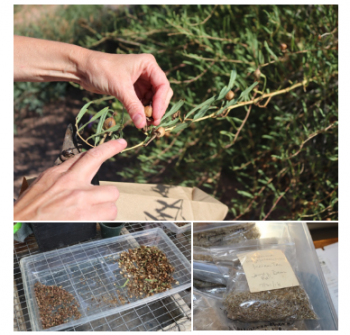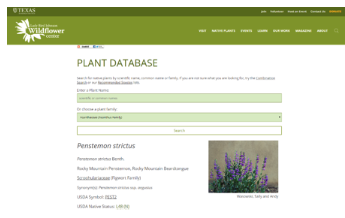September 14, 2019
Growing Native Plants Does Not Have to Be a Pain in the Aster
Guest columnist this week: Alissa Freeman - Senior Program Specialist and Director of the pollinator-friendly NMSU Learning Garden at the NMSU Agricultural Science Center at Los Lunas.
Question:
I recently attended a native plant seed-saving workshop and collected a few different native plant species. How do I grow these seeds?
- Emilio B., Belen, NM
Answer:
Not only are native plants a beautiful addition to any landscape but they also require less water, are adapted to our climate, and are a vital resource for native bees and other pollinators. Many native plants are available commercially, but it can be a fun and rewarding experience to try growing native plants at home. The first step is collecting seeds—go on hikes, walk around the bosque, and find your favorite areas that have plants of interest. When collecting seeds, make sure they are dry and ready to harvest and only collect a small percentage of available seed to keep the plant population healthy. Following seed collection, clean the seeds by peeling away excess plant material. Be sure to dry seeds out before storing in a cool, dry location to prevent molding.

Many native perennial seeds undergo a period of dormancy to prevent them from growing prematurely when conditions are not ideal. This requires different seed treatments to help break the dormancy period and germinate them successfully. A great resource to find out what treatment your seeds may require is Wild Flower.
Use this plant database to find your species of interest, and scroll through the page to find the “Propagation” section with general information on what treatment might be needed in order to get seeds to germinate. The two main treatment methods are stratification and scarification.
Stratification: Some seeds need to go through a cold moist stratification, which mimics the winter season. These seeds need to be in moist storage for long periods of time at temperatures below 40°F (but above freezing). This can be achieved by storing seeds in moistened sand or vermiculite in ziplock bags stored in the refrigerator. The amount of time these seeds need to be in cold moist stratification depends largely on the species, but is usually between 60 and 90 days. Additionally, some seeds require just cold dry stratification, which requires to be stored in temperatures below 40°F (but above freezing) with no moisture treatment. Other seeds may require warm moist stratification—seeds mixed in sterile soil, sealed in a plastic bag, and stored at 80°F for 60–90 days—or a combination of cold moist stratification and warm moist stratification.

Scarification: Seeds that need scarification have a hard seed coat (outer protective layer) that prevents water from reaching the embryo and triggering germination. For example, seeds in the legume family (Fabaceae) generally require scarification, or some type of damage to the seed coat, to germinate. This can be achieved in the home by:
- Using sandpaper to damage the seed coat
- Soaking seeds in hot water to soften the seed coat, or
- Sowing seeds outdoors in the fall and exposing them to winter conditions
Information regarding different propagation techniques, including how to test seed when germination requirements are not known, can be found in the NMSU Extension Guide H-122: Seed Propagation of Plants. Visit the blog this week for more in-depth links offering info on growing trees from seed and other plant propagation techniques.
Marisa Y. Thompson, PhD, is the Extension Horticulture Specialist, in the Department of Extension Plant Sciences at the New Mexico State University Los Lunas Agricultural Science Center, email: desertblooms@nmsu.edu, office: 505-865-7340, ext. 113.
Links:
For more gardening information, visit the NMSU Extension Horticulture page at Desert Blooms and the NMSU Horticulture Publications page.
Send gardening questions to Southwest Yard and Garden - Attn: Dr. Marisa Thompson at desertblooms@nmsu.edu, or at the Desert Blooms Facebook page.
Please copy your County Extension Agent and indicate your county of residence when you submit your question!